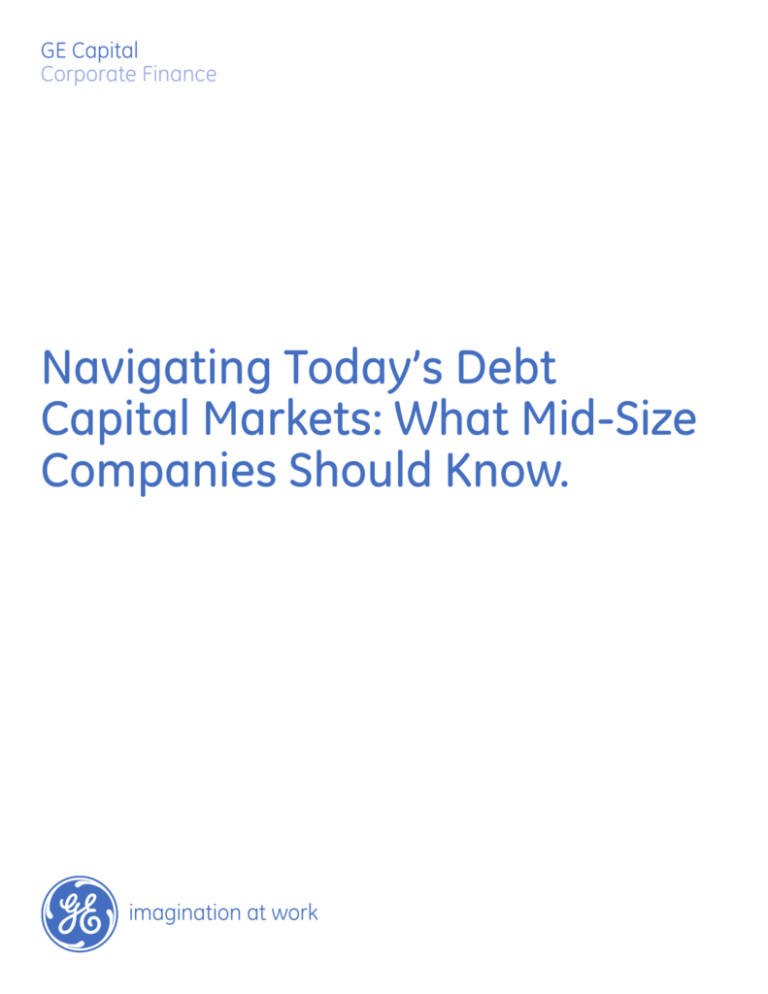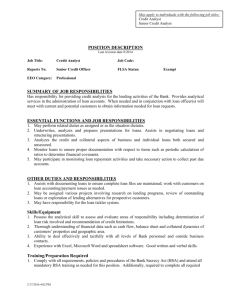
GE Capital
Corporate Finance
Navigating Today’s Debt
Capital Markets: What Mid-Size
Companies Should Know.
imagination at work
GE Capital
Corporate Finance
Navigating Today’s Debt
Capital Markets: What Mid-Size
Companies Should Know.
By Bob McCarrick, Chief Commercial Officer, Lending at GE Capital, Corporate Finance
The U.S. economic recovery is firmly underway and the growth prospects for many
mid-size companies are better today than they’ve been for half a decade or more.
The Federal Open Market Committee expects steady growth in the 3% range through
the end of 2014 and it’s also pledged to keep its ultra-low benchmark interest rate
until 2015.
For mid-size companies—those with anywhere from $10 million
to $1 billion in revenue—the combination of steady growth
and affordable capital is rare indeed. There is also ample
liquidity as traditional middle market lenders are being joined
by institutional investors with deep pockets and a strong desire
to participate in these loans. What’s more, new products are
available that give borrowers more flexibility.
In short, it’s a near ideal environment for mid-size company
borrowers. However, that doesn’t make navigating the debt
capital markets any easier. With more lenders and more
options, it’s arguably become more complex. There are new
senior debt options available from banks, financial companies
and institutional investors that can be structured as either
asset-based loans (ABL) or cash-flow-based loans. Junior debt
offerings in the form of second-liens and mezzanine funding
remain widely available in the private market. Meanwhile, the
biggest mid-size firms could bypass these private offerings
altogether and tap the public debt markets instead, where they
can lock in low rates for longer periods. CEOs and CFOs looking
to take advantage of the current environment to ramp up
GE Capital, Corporate Finance • 800-326-6342 • gecapital.com/corporatefinance
borrowing should keep a few developments in mind.
Liquidity from Institutional Investors
In the past, lending to mid-size companies was dominated by
banks and finance companies. But now large institutions such
as pension funds, hedge funds and bank run mutual funds
are getting involved and account for 60-70% of senior lending
at the higher revenue end of the middle market. While these
institutions lend directly to the company, they typically don’t
have a direct relationship; instead they participate in syndicates
arranged by an agent such as a bank or finance company.
A big reason for this increase in lending is institutional
investors’ desire to diversify their holdings from fixed-rate
debt to include more floating-rate debt, which offers some
protection should interest rates start to rise. Plus, the yield
is relatively good. Asset-based lending for middle market
companies is typically 175-200 basis points over the London
Interbank Offered Rate (LIBOR) while cash flow lending is
usually rating-dependent with typical spreads at LIBOR plus
300-500 basis points.
GE Capital
Corporate Finance
The Return of Products, and Flexibility
Historically, the long-term financing available in the bond
markets has only been open to larger mid-size companies
with revenues closer to $1 billion. Most middle market
companies have had to settle for bank loans that amortized
in five years. But following the financial crisis, institutional
investors are once again re-emerging to
offer bond-like facilities to smaller middle
market companies. They’re offering
loans with virtually no amortization, as
low as 1%, so these loans function more
like bonds.
Other borrower-friendly products
include “delayed draw facilities” and
“incremental draw facilities.” In a
traditional loan, the company gets all
the money up front and immediately
begins paying interest on the whole loan.
For a fee, delayed draw facilities give a
company the flexibility to draw down
the cash and begin paying interest when
they need it—often over a one- or twoyear window. It’s similar to a revolver but
in the form of a term loan. It can be a
cost effective option for borrowers.
Loan Primer” by Standard and Poors, a syndicated loan is
provided by a group of lenders and is structured, arranged,
and administered by one or several commercial or investment
banks known as arrangers or agents. There are three types of
syndications: in an underwritten deal the arranger guarantees
the entire loan and then places part or all of the loan with
a group of lenders. In a “best-efforts”
syndication the arranger commits to
underwrite less than the entire amount
of the loan, which means if other lenders
can’t be found the loan may not close.
Finally, there is the “club deal.” These are
smaller loans, usually $25 million to $100
million, but as high as $150 million that
are pre-marketed to a group of lenders.
The arranger is generally a first among
equals, and each lender gets a full cut, or
nearly a full cut, of the fees.
“In short, it’s a
near ideal
environment for
mid-size company
borrowers.
However, that
doesn’t make
navigating the debt
capital markets
any easier.”
In all types of syndications, the agent’s
relationships with other lenders and
the ability to hold part of the loan
on its own books are critical to the
smooth execution of the deal. Before
the financial crisis, many agents would
syndicate the entire loan and not hold
any on their own books. That wasn’t a
problem unless, as frequently happened during the financial
What’s more, as banks and institutional investors compete
crisis, the borrower ran into a rough patch and tried to amend
for assets in a slow growth economy, “covenant-lite” loans for
the loan terms. If its agent didn’t own the loan, the borrower
mid-size companies have also returned. Loan covenants are
had to negotiate
certain measures
with a large group of
that serve as early
lenders with whom it
Middle Market Leveraged Loan Volume by Year ($B)
warning signs
had no relationship.
should a borrower
$34.8
$34.2
For this reason, many
run into trouble.
mid-size company
Covenant-lite loan
$28.7
$26.0
Pro Rata
borrowers now
agreements have
prefer to have their
fewer restrictions and
Institutional
$14.3
agent and a few core
allow the borrower
$12.5
$11.7
$10.3
lenders hold at least
greater flexibility and
$8.0
$5.3
51% of the loan. This
often fewer reporting
also makes the initial
requirements.
’03
’04
’05
’06
’07
’08
’09
’10
’11
’12
syndication easier
Source: Standard & Poor’s LCD
since less of the loan
The Importance of
must be placed.
Holding and Trading
There are some
Some borrowers might also benefit from an agent that actively
important lessons from the financial crisis that CEOs and CFOs
trades in the secondary market—where investors buy and sell
should consider when assessing lenders. One of these is the
previously issued loans—and makes a market for its loans. This
lender’s loan syndication strategy. According to “A Syndicated
GE Capital, Corporate Finance • 800-326-6342 • gecapital.com/corporatefinance
GE Capital
Corporate Finance
trading activity offers valuable insight into how the company is
viewed by the market. If, for instance, a company’s loan trades
above par, it’s a sign that lenders might be willing to extend the
company a new loan at a lower interest rate, as with bonds,
loan prices and interest rates are inversely related.
Regulatory Outlook
CEOs and CFOs may benefit by remaining attune to the
regulatory issues that lenders’ face, which have become more
burdensome since the financial crisis. For instance, the Federal
Reserve just released new guidance for highly leveraged
transactions (HLTs) directing all lenders to be extra vigilant
when underwriting loans and demonstrate adequate capital
to withstand losses. It’s too early to know the effects of the
new guidance with certainty, but it could dampen some bank
lending in the future.
imagination at work
Overall, however, the environment for mid-size company
borrowers has rarely been brighter. More lenders, new products
and good terms mean that quality companies have access to
capital to grow and take advantage of the country’s economic
recovery. By keeping a few key developments in mind, CEOs
and CFOs can successfully navigate today’s debt markets and
build a long-lasting relationship with the right lender.
Bob McCarrick (robert.mccarrick@ge.com),
is Chief Commercial Officer, Lending at
GE Capital, Corporate Finance, specializing in
providing commercial loans and equipment
finance to mid-size companies for growth,
acquisitions, turnarounds and balance sheet
optimization. gecapital.com/corporatefinance
This piece provides general information and should not be used or taken as business, financial, tax,
accounting, legal or other advice, or relied upon in substitution for the exercise of your independent
judgment. For your specific situation or where otherwise required, expert advice should be sought.
GE Capital, Corporate Finance • 800-326-6342 • gecapital.com/corporatefinance
GE Capital
Corporate Finance
Flexible financing—plus the know-how to
make the most of it.
At GE Capital, Corporate Finance, we’re not just bankers. We’re builders.
That’s why we provide financing solutions to help build your business.
We also provide access to a wealth of tools and hard-earned insights
that can help your business grow. Stop just banking. And start building.
Visit gecapital.com/corporatefinance to tap into all we have to offer.
GE #CapitaLens talks tax exempt financing & financial forecasting
10/8/13 7:48 AM
August 2012
GE Capital
GE Capital
Corporate Finance
Industry Research Update
Find Financing Now
Subscribe to CapitaLens
Food, Beverage & Agribusiness
Share CapitaLens:
Recent Developments
• U.S. consumer confidence improved 8.5% in
December, reaching 78.1 (1985=100), according to
The Conference Board. Consumers expressed
greater optimism regarding both short and long
term economic and employment conditions.
Navigating Today’s Debt
Capital Markets: What Mid-Size
Companies Should Know
• From freezing orange groves in Florida to reduced
cattle processing in the Great Plains, recent severe
weather in the U.S. is impacting many commodities.
• Prices paid to coffee bean growers have decreased
-20% Y/Y in 2013 due to global oversupply. Retail
coffee prices, in contrast, have remained relatively
constant.
• The National Restaurant Association’s Performance
Index rose 0.3% in November versus prior month,
attributed to increases in same store sales and
customer traffic.
Industry Fundamentals
Informative Webinar
Food on the Run: How Companies Can Grow with America's On-the-Go Eaters
October 22, 2013 at 1:00 p.m. ET
Food companies that cater to opportunistic eaters may well reap
disproportionate growth. Join GE Capital's industry analysts for the latest Food &
Beverage market trends. Plus, special guest Susan Viamari, Editor, IRI's Times
and Trends, will reveal findings from the consumer survey "How America Eats:
Capturing Growth with Food on the Run." Register Now
Industry Research
An overview of current trends and
information of interest. Enroll to receive
insight in more than 10 industries.
Consumer and Producer Price Indices
12%
CPI - Food & Beverages
10%
The Consumer Price Index (CPI) for food and
beverages increased +1.2% in November Y/Y.
Food at home prices rose +0.6%, a slower rate
than the +2.1% increase in food away from
home.
PPI - Finished Consumer Foods
8%
Y/Y Change (%)
CapitaLens eNewsletter
Sign up to receive our monthly
eNewsletter on working and growth
capital for mid-size businesses.
Improving consumer confidence levels, decreasing unemployment and positive trends in the housing market are all
encouraging indicators for food and beverage spending in the new year.
6%
4%
The Producer Price Index (PPI) increased
+0.6% Y/Y in November, according to the U.S.
Bureau of Labor Statistics.
2%
0%
-2%
-4%
-6%
Jan- 11
Source: U.S. Bureau of Labor Statistics
May- 11
Sep- 11
Jan- 12
May- 12
Sep- 12
View Webinar Library
Jan- 13
May- 13
Sep- 13
By Bob McCarrick, Chief Commercial Officer—Lending
The U.S. economic recovery is firmly underway and the growth prospects for many
mid-size companies are better today than they’ve been for half a decade or more.
The Federal Open Market Committee expects steady growth in the 3% range through
the end of 2014 and it’s also pledged to keep its ultra-low benchmark interest rate
until 2015.
For mid-size companies—those with anywhere from $10 million
to $1 billion in revenue—the combination of steady growth
and affordable capital is rare indeed. There is also ample
liquidity as traditional middle market lenders are being joined
by institutional investors with deep pockets and a strong desire
to participate in these loans. What’s more, new products are
available that give borrowers more flexibility.
borrowing should keep a few developments in mind.
Liquidity from Institutional Investors
In the past, lending to mid-size companies was dominated by
banks and finance companies. But now large institutions such
as pension funds, hedge funds and bank run mutual funds
are getting involved and account for 60-70% of senior lending
at the higher revenue end of the middle market. While these
institutions lend directly to the company, they typically don’t
have a direct relationship; instead they participate in syndicates
arranged by an agent such as a bank or finance company.
Informative White Papers
You’ll find topics ranging from key
developments in the debt markets to tips
for smart borrowers and more.
In short, it’s a near ideal environment for mid-size company
borrowers. However, that doesn’t make navigating the debt
capital markets any easier. With more lenders and more
options, it’s arguably become more complex. There are new
senior debt options available from banks, financial companies
and institutional investors that can be structured as either
asset-based loans (ABL) or cash-flow-based loans. Junior debt
offerings in the form of second-liens and mezzanine funding
remain widely available in the private market. Meanwhile, the
biggest mid-size firms could bypass these private offerings
altogether and tap the public debt markets instead, where they
can lock in low rates for longer periods. CEOs and CFOs looking
to take advantage of the current environment to ramp up
A big reason for this increase in lending is institutional
investors’ desire to diversify their holdings from fixed-rate
debt to include more floating-rate debt, which offers some
protection should interest rates start to rise. Plus, the yield
is relatively good. Asset-based lending for middle market
companies is typically 175-200 basis points over the London
Interbank Offered Rate (LIBOR) while cash flow lending is
usually rating-dependent with typical spreads at LIBOR plus
300-500 basis points.
Industry Research Update: Food Beverage & Agribusiness 1
Explore Financing Solutions at www.gecapital.com/americas
© Copyright 2013 General Electric Capital Corporation, All Rights Reserved.
Industry Insights in Over 10 Sectors
GE Capital, Corporate Finance • 800-326-6342 • gecapital.com/americas
M I d dGE's
lindustry
e research gives you in-depth analysis in 10+ industry sectors.
Learn More
Mark
eT
IndICaTOr
What's Moving Interest Rates?
Revenue growth continues.
EN
ST
M
FID
N
VE
CO
IN
IN
IR
H
RE
VE
N
G
UE
EN
T
CE
Benefit from GE's perspective on market themes, events and economic data
that may move U.S. interest rates. Learn More
OPTIMISM In The
MIddle MarkeT
Employment gaining momentum.
Administrative Agent • $110 Million • Asset-Based Credit Facility
5.1
market companies
GE Capital, Corporate Finance isMiddle
administrative
agent and sole lender on a $110
are forecasted to generate
million asset-based credit facility for Arthur Schuman, Inc., a leading cheese
* debt and will be used
manufacturer and1.2%
distributor. The loan refinances existing
to support growth. Read the Press Announcement
%
View more
Middle Market growth
over the next 12 MonthS
65%
S&P 500
DoneProjected
Deals
growth
70%
of all new projected jobs this year.
2.5%
Middle Market
eMPloYMent
growth over the
next 12 MonthS
43%
of middle market
companies anticipate
61%Angst, U.S. CFOs Anticipate Growth
Despite
Healthcare
Cost
positive gross
revenue
of middle market
performance over the
Though
U.S. finance chiefs have concerns over healthcare companies
costs, they
next 12 months.
jobs.
* Source: BLS and MMI data.
anticipate profits will jump more than
10 percent and capitaladding
spending
could
rise nearly five percent. Learn More
Companies are becoming more confident
in the global, U.S. and local economies.
Capital investment
poised to surge.
http://www.gelending.com/Clg/CapitaLens/2013/10-2013/ge-enewsletter-capitalens-10-2013-web.html
National Center for the Middle Market
64%
A GE Capital and Ohio State University
%
%
%
collaboration
that
focuses
on
research
48
79
64
51%
and ideas
22% for mid-size
50%
67% companies.
GLOBAL ecOnOmy
|||||||||||||||||||||||||
2Q’12
nATIOnAL ecOnOmy
LOcAL ecOnOmy
vs. 1 yeAr AGO
|||||||||||||||||||||||||
2Q’12
Middle market
companies are
sending a strong
message that they
are poised to invest
capital to add jobs,
equipment, make
acquisitions or
train employees.
will inveSt
2Q’12
2Q’12
Page 1 of 2
Access GE Webinars
Get the latest in economic updates,
industry insights and best practices from
GE experts and industry thought leaders.
FOR MORE INFORMATION
VISIT MIDDlEMARkETCENTER.ORG
In Collaboration With
In Collaboration With
imagination at work
Stay Connected
View some of our customers on YouTube,
explore our LinkedIn page and follow us
on Twitter @GELendLease.









